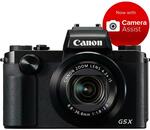The PowerShot G5 X combines uncompromising image quality from a 1.0-type back-illuminated 20.2 Megapixel CMOS sensor with the exceptional speed of a DIGIC 6 processor, all packaged into beautifully compact body.
For the more advanced photographer, the PowerShot G5 X’s range of manual controls and high resolution OLED electronic viewfinder offers DSLR-like handling and maximum comfort when shooting.
Canon PowerShot G5X Digital Camera $498 + Delivery ($0 C&C /In-Store) @ JB Hi-Fi (Expired) /Delivered @ Amazon AU
Last edited 19/08/2020 - 04:23 by 2 other users
Related Stores
closed Comments

Just for anyone wondering: this is definitely the original G5X, not the Mark II.

Is this better than the G7x?

Had this. The video stabilisation is insane. One of the best tbh

It only has digital image stabalisation?

Pretty sure it was optical and digital stabilisation. Only fhd though.
But for me, it was extremely stable.

Whats the Point of these when phones Shoot better?

People have downvoted you and it seems like a troll comment, but I have 10 minutes so I will answer you honestly and give you the benefit of the doubt (at least for now). It’s all based on my opinion of course, not fact, but I don’t think I’m leading you astray in any way.
Firstly, a 1 inch (not actually 1 inch but by name) sensor is far larger than anything in most phones (usually a 1/2.3” sensor). A larger sensor combined with much larger and potentially higher quality lenses (higher aperture/better glass) allows for pictures completely different to those from a phone. Phone software usually heavily modifies the raw photo data (not to be confused with RAW format) to enhance the ‘look’ of the photo but is a ‘one-way-street’ ie the modification has been done and saved as a compressed file (say, Jpeg) when it arrives in your photo album. This means that the photo is effectively photoshopped permanently already to some extent. Any camera that saves as a jpeg will be doing this to some extent but phones will tend to inherently rely on this more aggressively due to factors including but possibly not limited to the limitations mentioned above and below. This last point is probably a bonus for anyone who just wants to take a photo and use it as is, but a major downside to anyone who wants to crop, enhance, or edit photos as a lot of the original detail and information is already lost (or was not of high quality to begin with).
Manual controls that are available with a DLSR are very good at allowing photographers to take photos in extremely dynamic situations - ranging from lighting, focusing and movement changes. Although this isn’t a DSLR, some higher end compacts allow some custom changes in a similar way.
If you’ve ever used an SLR, you’ll know the difference in ‘feel’ between that and a compact camera - when you click the shutter button (for example) there is an instant shot taken at that exact moment because it’s not a button that starts a slow computer controlled sequence of events to take the shot (to some extent), it’s instead a release of the actual physical device shutter (gives a feeling of extreme responsiveness) and although software can be used to make it feel like the button click is taking the photo straight away, there is often a delay in processing which may be large enough to separate the captured image from what you thought you were capturing or to miss a shot due to focus or lighting change speed (which are often very fast in dedicated higher end cameras - but not all). This camera in the post is not an SLR, but the description would imply the ‘feel’ is closer to a DSLR camera - and some of the larger cameras (like the fz80 bridge sized ones) will feel a little more like this.
These are just some of the reasons why I would choose a standalone camera over a phone - I just realised I didn’t even mention optical zoom or physical stabilisation capability - or even the price of this camera if you don’t already own a phone that cost 3 or 4 times as much. Not everyone needs it, but there is no doubting a standalone at the moment, (can) be a much better product for taking photos as described above.
Phone cameras are getting better all the time, but they are not yet anywhere near as good as a (higher end) camera in relation to what I’ve mentioned. It’s possible this will never be the case as whatever the phons end up with, there is always going to be more physical space in a standalone camera to contain better optics. But this may change, we’ll have to wait and see. (Not to mention the optics / sensors used in phones are sometimes made by the same companies as the cameras and so whatever tech they have for the phone can be used in their more dedicated models but with less limitation).
Just as a bit of an example. There was a brilliantly bright moon in a clear sky a couple nights ago. I went to take a photo with my iPhone 11 pro (which honestly does take photos that look fantastic if I just want to point and click). I couldn’t for the life of me get the clear shot. The focus just wouldn’t compensate or hold in any mode or with any tricks I tried. The moon was too small on the screen for it to detect correctly, meanwhile the light was changing around me a little also. My partner’s S20 work phone which we tried to use had similar issues. There may very well be a way to sort this out, but in the end I went and got my Rx100 and as expected the photo was perfect first time, no fuss.

Thanks for taking time to answer. Points taken.

I still got a Canon G16 and dont know what to do with it. Bought it around the same price in 2014.

This is a decent price point. As time moves on, it's getting harder and harder to justify these compact point and shooters. Including these g series cameras which are fantastic tactile products if you're into that sort of thing. This is a cool piece of tech, a lot to play with if you have time to be an enthusiast, so in a way it's almost something you'd buy a kid to learn photography on, but then it's too expensive for that. For 500, I'd go with a base dslr or stretch for a mirrorless, like the m50 or a6000 where you'll get more longevity from playing with different lenses. This only shoots in 1080p as well which is dated for 2020.

Good advice.
I had a good opportunity to get out of my Olympus em-1 and arsenal of lenses and purchased a RX100 IV for a great price while I still had the Olympus gear.
Now the RX100 seemingly collects more dust than it gets used but for at least half of its value it's hardly worth selling so I've considered keeping it as a camera for the kids as opposed to selling and buying and being caught up in all that back and forth effort .
Other than playing with physical lenses, (high-end) compacts still teach you the same concepts without the fragility of removable lenses.
As I said, great advice but if you already have a quality P&S or value their inherent compact, then they definitely still have their place and I'd argue even put some entry level SLRs to shame - another topic of discussion given the complexity of some entry level SLRs that more or less turn people off the hobby more than encourage them. P&Ss tend to be less intimidating.
Just my 2c. Decent deal. 👍

I used to own a DSLR but found it didn’t get much use as I didn’t like carrying it + a lens (or two) around.
I moved to a high end compact like this one which fits in a coat pocket or small camera bag and haven’t looked back.

Dammit! I got my new Canon camera 2 days ago, missed on a great deal. What even is this timing?

Amazon has matched da price for those who are keen: https://www.amazon.com.au/Canon-PowerShot-G5X-Australian-war…

I have a panasonic fz80 and I'm not happy with it. The photos taken with it are terrible.
Is this one better? Should I sell the fz80 and get this one instead?


not a bad price, but a 5 year old camera.